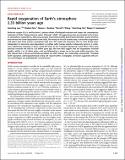| dc.contributor.author | Luo, Genming | |
| dc.contributor.author | Ono, Shuhei | |
| dc.contributor.author | Beukes, Nicolas J. | |
| dc.contributor.author | Wang, David T. | |
| dc.contributor.author | Xie, Shucheng | |
| dc.contributor.author | Summons, Roger E | |
| dc.date.accessioned | 2016-06-06T20:47:36Z | |
| dc.date.available | 2016-06-06T20:47:36Z | |
| dc.date.issued | 2016-05 | |
| dc.identifier.issn | 2375-2548 | |
| dc.identifier.uri | http://hdl.handle.net/1721.1/103006 | |
| dc.description.abstract | Molecular oxygen (O[subscript 2]) is, and has been, a primary driver of biological evolution and shapes the contemporary landscape of Earth’s biogeochemical cycles. Although “whiffs” of oxygen have been documented in the Archean atmosphere, substantial O2 did not accumulate irreversibly until the Early Paleoproterozoic, during what has been termed the Great Oxygenation Event (GOE). The timing of the GOE and the rate at which this oxygenation took place have been poorly constrained until now. We report the transition (that is, from being mass-independent to becoming mass-dependent) in multiple sulfur isotope signals of diagenetic pyrite in a continuous sedimentary sequence in three coeval drill cores in the Transvaal Supergroup, South Africa. These data precisely constrain the GOE to 2.33 billion years ago. The new data suggest that the oxygenation occurred rapidly—within 1 to 10 million years—and was followed by a slower rise in the ocean sulfate inventory. Our data indicate that a climate perturbation predated the GOE, whereas the relationships among GOE, “Snowball Earth” glaciation, and biogeochemical cycling will require further stratigraphic correlation supported with precise chronologies and paleolatitude reconstructions. | en_US |
| dc.description.sponsorship | National Science Foundation (U.S.) (EAR-1338810) | en_US |
| dc.description.sponsorship | National Natural Science Foundation (China) ((grant no. 41472170) | en_US |
| dc.description.sponsorship | Wellcome Trust Sanger Institute ( 111 Project grant no. B08030) | en_US |
| dc.description.sponsorship | National Basic Research Program of China (973 Program) | en_US |
| dc.description.sponsorship | United States. National Aeronautics and Space Administration (NASA Astrobiology Institute award NNA13AA90A) | en_US |
| dc.language.iso | en_US | |
| dc.publisher | American Association for the Advancement of Science (AAAS) | en_US |
| dc.relation.isversionof | http://dx.doi.org/10.1126/sciadv.1600134 | en_US |
| dc.rights | Creative Commons Attribution-Noncommercial | en_US |
| dc.rights.uri | http://creativecommons.org/licenses/by-nc/4.0/ | en_US |
| dc.source | Science | en_US |
| dc.title | Rapid oxygenation of Earths atmosphere 2.33 billion years ago | en_US |
| dc.type | Article | en_US |
| dc.identifier.citation | Luo, Genming, Shuhei Ono, Nicolas J. Beukes, David T. Wang, Shucheng Xie and Roger E. Summons, "Rapid oxygenation of Earth’s atmosphere 2.33 billion years ago." Science Advances, Vol. 2, no. 5, (May 2016), e1600134. | en_US |
| dc.contributor.department | Massachusetts Institute of Technology. Department of Earth, Atmospheric, and Planetary Sciences | en_US |
| dc.contributor.mitauthor | Luo, Genming | en_US |
| dc.contributor.mitauthor | Ono, Shuhei | en_US |
| dc.contributor.mitauthor | Wang, David T. | en_US |
| dc.contributor.mitauthor | Summons, Roger E. | en_US |
| dc.relation.journal | Science Advances | en_US |
| dc.eprint.version | Final published version | en_US |
| dc.type.uri | http://purl.org/eprint/type/JournalArticle | en_US |
| eprint.status | http://purl.org/eprint/status/PeerReviewed | en_US |
| dspace.orderedauthors | Luo, G.; Ono, S.; Beukes, N. J.; Wang, D. T.; Xie, S.; Summons, R. E. | en_US |
| dspace.embargo.terms | N | en_US |
| dc.identifier.orcid | https://orcid.org/0000-0002-7144-8537 | |
| dc.identifier.orcid | https://orcid.org/0000-0002-7380-3707 | |
| dc.identifier.orcid | https://orcid.org/0000-0002-1348-9584 | |
| dc.identifier.orcid | https://orcid.org/0000-0002-2656-8951 | |
| mit.license | PUBLISHER_CC | en_US |
